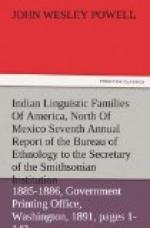= Huron-Cherokee, Hale in Am. Antiq.,
20, Jan., 1883 (proposed as a
family name instead of Huron-Iroquois;
relationship to Iroquois
affirmed).
Derivation: French, adaptation of the Iroquois word hiro, used to conclude a speech, and koue, an exclamation (Charlevoix). Hale gives as possible derivations ierokwa, the indeterminate form of the verb to smoke, signifying “they who smoke;” also the Cayuga form of bear, iakwai.[39] Mr. Hewitt[39] suggests the Algonkin words [-i]r[-i]n, true, or real; ako, snake; with the French termination ois, the word becomes Irinakois.
[Footnote 39: Iroquois Book of Rites, 1883, app., p. 173.]
[Footnote 40: American Anthropologist, 1888, vol. 1, p. 188.]
With reference to this family it is of interest to note that as early as 1798 Barton[41] compared the Cheroki language with that of the Iroquois and stated his belief that there was a connection between them. Gallatin, in the Archaeologia Americana, refers to the opinion expressed by Barton, and although he states that he is inclined to agree with that author, yet he does not formally refer Cheroki to that family, concluding that “We have not a sufficient knowledge of the grammar, and generally of the language of the Five Nations, or of the Wyandots, to decide that question."[42]
[Footnote 41: New Views
of the Origin of the Tribes and Nations of
America. Phila., 1798.]
[Footnote 42: Trans. Am. Antiq. Soc., 1836, vol. 2, p. 92.]
Mr. Hale was the first to give formal expression to his belief in the affinity of the Cheroki to Iroquois.[43] Recently extensive Cheroki vocabularies have come into possession of the Bureau of Ethnology, and a careful comparison of them with ample Iroquois material has been made by Mr. Hewitt. The result is convincing proof of the relationship of the two languages as affirmed by Barton so long ago.
[Footnote 43: Am. Antiq., 1883, vol. 5, p. 20.]
GEOGRAPHIC DISTRIBUTION.
Unlike most linguistic stocks, the Iroquoian tribes did not occupy a continuous area, but when first known to Europeans were settled in three distinct regions, separated from each other by tribes of other lineage. The northern group was surrounded by tribes of Algonquian stock, while the more southern groups bordered upon the Catawba and Maskoki.
A tradition of the Iroquois points to the St. Lawrence region as the early home of the Iroquoian tribes, whence they gradually moved down to the southwest along the shores of the Great Lakes.
When Cartier, in 1534, first explored the bays and inlets of the Gulf of St. Lawrence he met a Huron-Iroquoian people on the shores of the Bay of Gaspe, who also visited the northern coast of the gulf. In the following year when he sailed up the St. Lawrence River he found the banks of the river from Quebec to Montreal occupied by an Iroquoian people. From statements of Champlain and other early explorers it seems probable that the Wyandot once occupied the country along the northern shore of Lake Ontario.




